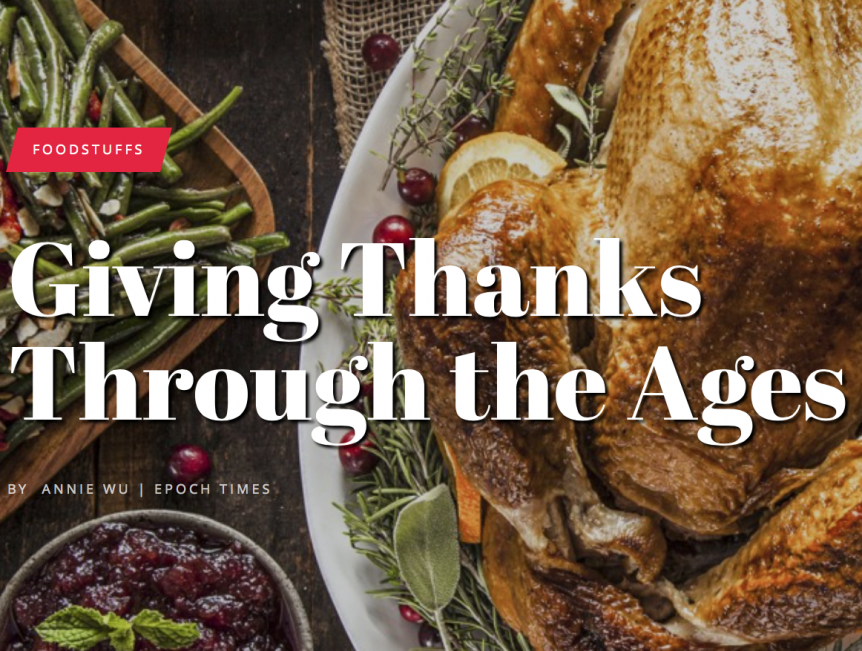CLICK HERE for the article in Epoch Times
CLICK HERE for the recipe for Green Beans with Oyster Mushrooms
CLICK HERE for the recipe for Pumpkin Pie Bread and Muffins
At the very core of the Thanksgiving holiday lies the idea of expressing gratitude for the plentiful harvest. Since the beginning of civilization, people have praised the heavens for bestowing a bounty of fruit, vegetables, and grains—whether by poetic verse, festive celebration, or ceremonial ritual.
From Old World to New World
The Sumerians in ancient Mesopotamia, for example, wrote a hymn to the goddess of beer, Ninkasi, which doubled as a recipe. A clay tablet was discovered with the lyrics written in Sumerian script, describing the process for making beer from hulled grains and honey.
“Occasions for giving thanks over food go back through all of human history,” authors Myra Kornfeld and Stephen Massimilla wrote in an email interview. Their new book, “Cooking With the Muse: A Sumptuous Gathering of Seasonal Recipes, Culinary Poetry, and Literary Fare” (Tupelo Press), looks to works of literature for cooking inspiration.
Their recipes focus on seasonal produce, borrowing a page from verse and prose throughout history that have referenced said vegetable or fruit. Kornfeld often gives cooking tips and nutrition facts, while Massimilla relates interesting tidbits from literature and different cultural traditions about the ingredients.
Celebrating the Harvest
In ancient Greece, the harvest was personified by Demeter, goddess of grain, who was worshipped for giving fertility to the earth. In the New World, Native American tribes performed dance rituals during the time of harvesting corn. The days-long ceremony would involve the whole pueblo, Kornfeld and Massimilla explained.
In the English language tradition, the two authors pointed to poet John Keats, who penned a loving tribute entitled “To Autumn.” Keats’s beginning stanzas especially reference food:
Season of mists and mellow fruitfulness,
Close bosom-friend of the maturing sun;
Conspiring with him how to load and bless
With fruit the vines that round the thatch-eves run;
To bend with apples the moss’d cottage-trees,
And fill all fruit with ripeness to the core;
To swell the gourd, and plump the hazel shells
With a sweet kernel; to set budding more […]
It was in this similar spirit that America’s modern concept of Thanksgiving was born. Early English settlers in the American colonies occasionally celebrated their harvest season with a day of prayer and giving thanks. But it wasn’t until President Abraham Lincoln declared Thanksgiving a national holiday in 1863 that it became a regularly observed festivity.
In the spirit of promoting unity against the backdrop of the Civil War, Kornfeld and Massimilla explained, Lincoln issued a proclamation that began with the words: “The year that is drawing toward its close has been filled with the blessings of fruitful fields and healthful skies.”
Today, we show our gratitude by preparing a feast full of the beautiful produce available to us. Thanksgiving is all about preparing delicious dishes to pass on as one’s unique family traditions, generation after generation (click here for a green bean recipe by Kornfeld and Massimilla).
A Pie-Making Tradition
When delving into the great American tradition of pie-making for the holidays, Kornfeld and Massimilla bring up Harriet Beecher Stowe.
Stowe, the 19th-century writer who ignited the abolitionist movement after publishing “Uncle Tom’s Cabin,” penned a novel about rural life in New England, called “Oldtown Folks.” In a scene about a Thanksgiving celebration, she writes about the amazing variety of pies that can be crafted from fruit:
“The pie is an English institution, which, planted on American soil, forthwith ran rampant and burst forth into an untold variety of genera and species. … Pumpkin pies, cranberry pies, huckleberry pies, cherry pies, green-currant pies, peach, pear, and plum pies, custard pies, apple pies, Marlborough-pudding pies—pies with top crusts, and pies without—pies adorned with all sorts of fanciful flutings and architectural strips laid across and around …”
In their cookbook, Kornfeld and Massimilla feature an abundance of fall fruit in their recipe for an Apple-Pear-Cranberry Crumble, and creatively use pumpkin pie filling in recipes for Pumpkin Pie Bread (recipe here) and Pumpkin Pie Soufflé.
In this time of family gatherings, at times joyful, at times stressful, Kornfeld and Massimilla remind us of these words from novelist Oscar Wilde: “After a good dinner, one can forgive anybody, even one’s own relations.” So bring on the turkey, and the green beans, and the stuffing, and the pies, and let good cheer prevail.
Channaly Philipp contributed to this report.


